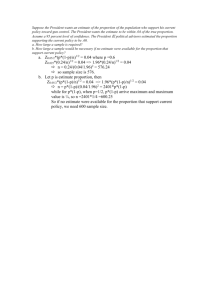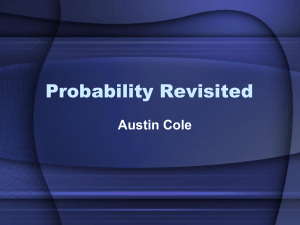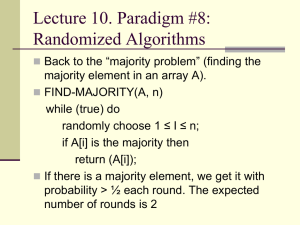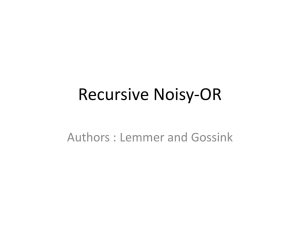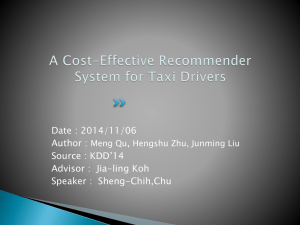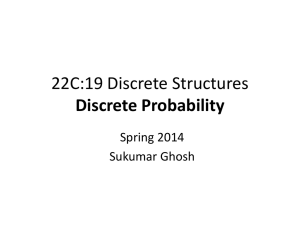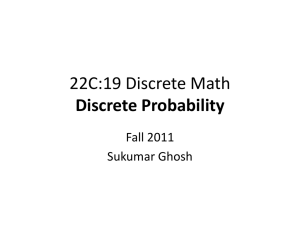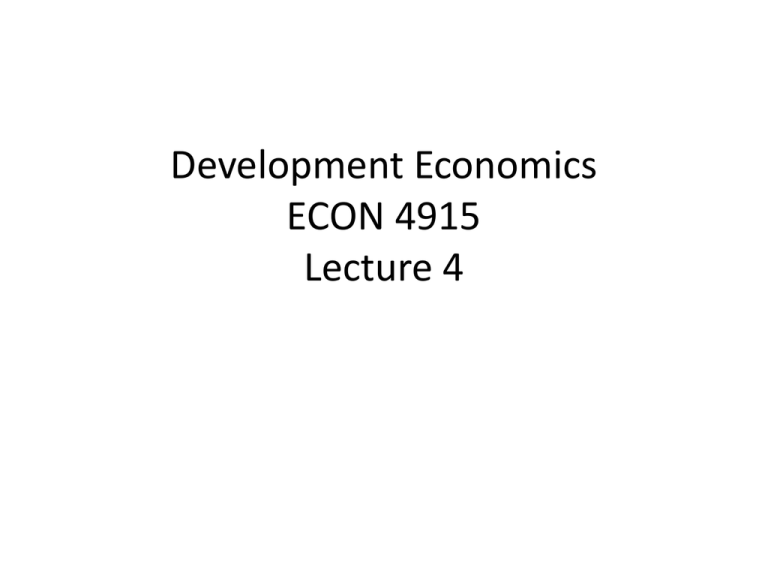
Development Economics
ECON 4915
Lecture 4
Outline
•
•
•
•
Seminar 3
Discussion on group lending
Possible exam question
Insurance
The problem of risk.
Why doesn’t insurance markets work well?
What can be done?
Seminar 3
• Each group will present an article for 20
minutes.
• E-mail me which article you choose.
• The articles will be distributed on a first come,
first served basis. (You are allowed to have the
same article across groups but not within
group).
• Acemoglu, D., S. Johnson, and J. A. Robinson (2001).The colonial origins of
comparative development: an empirical investigation, American Economic
Review 91(5), 1369-1401.
• Beaman, L. Chattopadhyay, R. Duflo, E., Pande, R, and Topolova P.
(2009).Powerful Women: Does Exposure Reduce Bias?Quarterly Journal of
Economics, 124 (4): 1497-1540.
• Fujiwara, T. (2010), Voting technology, political responsiveness, and infant
health: evidence from Brazil, University of British Columbia, mimeo.
• Glaeser E, La Porta L., Lopez-de-silanes F., and Schleifer, A.Do institutions
cause growth? Journal of Economic Growth, Vol. 9(3): 271-303.
• Jensen, R. and Oster, E. (2009).The Power of TV: Cable Television and
Women's Status in India*, The Quarterly Journal of Economics, 124 (3):
1057-1094.
• Nunn, N. and Wantchekon, L. (2009), The slave trade and the origins of
mistrust in Africa, NBER working paper.
• Qian, N. (2008), Missing women and the price of tea in China: The effect
of sex-specific earnings on sex imbalance, The Quarterly Journal of
Economics, 123(3): 1251-1285.
Focus on the following
• Research question
What is the precise question to be answered?
Is it interesting? Why should we care?
Is it new? What is the contribution of the paper?
Focus on the following
• Evidence
Is a causal effect identified?
Is the argument compelling?
Are alternative explanations ruled out?
Is the data appropriate?
Focus on the following
• Conclusion
Can the conclusion be generalized?
What are the main problems, if any?
What else would you like to know?
Group lending vs Individual lending
• When should we expect higher risk taking?
• How can we explain the results of the
Mongolian experiment?
Context? Time of evaluation? Or something deeper?
• What happens to adverse selection in this
study?
Typical exam question
• 3a) Banarjee and Duflo (2010) define
microcredit as innovations that lower the
administrative cost of making small loans.
Describe these innovations and discuss their
advantages and disadvantages (5 points).
Innovations
• Dynamic incentives.
• Group liability.
• Repayment frequency and social interactions.
• Simplified collection technology.
Typical exam question
• 3b) Evidence from behavioral economics
suggests that people are not always rational.
Discuss microcredit with reference to
problems of temptation and self-control (2
points).
Insurance
• The problem of risk.
• Why doesn’t insurance markets work well?
• What can be done?
Risk
• Risk is a central fact of life for poor people.
• Bad weather, for instance, can have disastrous
consequences.
• Another serious problem is that agricultural
prices fluctuate a lot.
Consequences of high risk
• Not only do the poor lead riskier lives than the
less poor, but a bad break of the same
magnitude is likely to hurt them more.
• First, a cut in consumption is more painful for
someone who consumes very little to start
with.
Consequences of high risk
• Second, when the relationship between
income today and future income is S-shaped,
the effect on the poor of a bad break may be
much worse than temporary unhappiness.
• Finally, the process is often reinforced by a
psychological process.
Consequences of high risk
• A common way of coping with risk is by being
very conservative on the farm or in the
business.
• So, the risk borne by the poor is not only
costly once a shock hits: The fear that
something bad might happen has an
independent effect on poor peoples ability to
fully realize their potential, or capabilities.
To reduce risk, smoothing of
consumption is necessary
• How smooth consumption?
• One way is via credit.
• We have already seen that this is not very
easy.
• Another way is via self-insurance.
Self-insurance
• Using one’s own wealth to smooth uncertain
shocks in income.
• The example of bullock markets (Rosenzweig
and Wolpin 1993).
“A bullock cart in India”
Mutual insurance can also be used to
smooth income
• We have two farmers, A and B.
• They produce the same crop and use the same
amounts of land and other inputs.
• The harvest yields 2000 NOK if all goes well
and 1000 if it goes bad.
• Probability of each event is 0.5.
Mutual insurance continued
• If they decide on a mutual insurance scheme
so that each farmer pays the other one 500
NOK in the case that one get a good harvest
and the other one a bad harvest.
• Then we get the following consumption
stream with probability 0.25: 2000, 1000,
1500, 1500.
Mutual insurance continued
• If the farmers are risk averse, this mutual
insurance increases expected utility.
• What happens if risks are perfectly positively
correlated?
• Perfectly negatively correlated?
The perfect insurance model
Assume a village with large number of identical farmers with income Y:
Y A
A= Average income
= Idiosyncratic error term
= Common error term.
Insure away the idiosyncratic risk
• So that all farmers recieve the same insured
income:
Y A
How can the theory be tested?
• If we have data over time from an entire
village we can test whether they have perfect
smoothing.
• Set up the following model:
Cht Cht 1 ( yt yt 1 ) ( yht yht 1 ) ht
• Where h=household, t=time, C= consumption,
and y= income.
Findings
• Townsend (1993) tested this in 3 villages in
southern India.
• Data on 40 households over time, every year
from 1975 to 1984.
• He could not reject that the coefficients on
the group consumption was 1, and he also
found that the coefficients on household
income were close to zero.
But what do we actually learn about
insurance?
• There are at least 2 reasons to be skeptical:
SUGGESTIONS?
1)…
2)…
Why might we expect a problem with
insurance?
• Ray offers 3 basic reasons:
Difficult to observe the final outcome
Difficult to observe effort
Difficult to enforce contracts
Difficult to observe the final
outcome
• People may simply lie and if statements about
outcomes are hard to verify, insurance may be
impossible.
• This has severe implications as it often limits
the possible range of insurance in geography.
• Institutions and social stratification are
important factors.
Difficult to observe effort
• Assume a large number of identical risk averse
farmers.
• All risk is idiosyncratic and output may be high (H)
or low (L).
• The probability of producing H is p if effort is high
and q if it is low.
• p>q.
• Cost of providing high effort=C
• u is the utility function.
The farmers net expected utility
Without insurance and high effort:
pu(H)+(1-p)u(L)-C
With low effort:
qu(H)+(1-q)u(L)
If we assume that each farmer in isolation find it
worthwhile to provide high effort we get that:
pu(H)+(1-p)u(L)-C >qu(H)+(1-q)u(L)
Then risk aversion implies that there
are gains from insurance
Risk aversion implies:
u(pH+(1-p)L) >pu(H)+(1-p)u(L)
If every farmer with high output pays (1-p)(H-L)
into a common pool and every farmer with low
output gets p(H-L), each farmer gets pH+(1-p)L
for sure.
So, what’s the problem?
• How are we going to ensure that each farmer put in
the high level of effort under the insurance scheme?
• If the level of effort is not observable to outside
parties, this will not be possible. This is so since each
farmer receives pH+(1-p)L for sure, i.e. regardless of
the level of effort and high effort is costly.
• So, there is a fundamental trade-off between the
provision of insurance and the provision of effort. If the
community wants to maintain effort at the high level, it
will have to offer incomplete insurance not to distort
incentives.
• So, informational constraints pose a real
problem to effective insurance.
• Groups with better access to information of
their members are therefore in a better
position for providing mutual insurance.
• Altruism…
• …and social norms more generally.
Difficult to enforce contracts
• Assume a large number of identical risk averse
farmers in a setting effort levels are perfectly
observable.
• All risk is idiosyncratic and output may be high (H)
or low (L) and the probability of producing H is p.
• Under perfect insurance each farmer receives
pH+(1-p)L as we saw before. Call this amount M.
• Let N be number of periods.
Difficult to enforce contracts
• In a given year with high output, the gain
from ignoring the insurance scheme is u(H) –
u(M).
• The loss is N{u(M) – [pu(H)+(1-p)u(L)]}
• Plus any social sanctions, S.
• The enforcement constraint is thus that:
N{u(M) – [pu(H)+(1-p)u(L)]}+S > u(H)-u(M)
What does this tell us?
• The larger S, the more social sanctions, the
more likely is it that the enforcement
constraint holds.
• If people are likely to interact over a longer
period, if N is higher, the more likely is it that
the enforcement constraint holds.
The problem of adverse selection
• Adverse selection: not knowing whether a client
is of high or low risk.
• Not well covered in Ray.
• Example with health insurance: those who know
that they are more likely to become sick in the
future may be more likely to get an insurance.
• Higher price may make it even worse as it drives
away those who know they will probably not
need the insurance.
So, as in credit markets…
• The fundamental problems of insurance are
moral hazard and adverse selection.
What can be done?
• Insure the weather instead of the crop, maybe
in a two tier system.
• Rapid Conflict Prevention Support (RCPS)
• Miguel and Fisman argue that this type of
insurance can play a big role in foreign aid.
• The state as a large risk pool.
Some questions at the research
frontier
• Behavioral development economics on the
psychological costs of poverty and risk.
• Why are some forms of risk less covered than
other?
• Micro-insurance.

